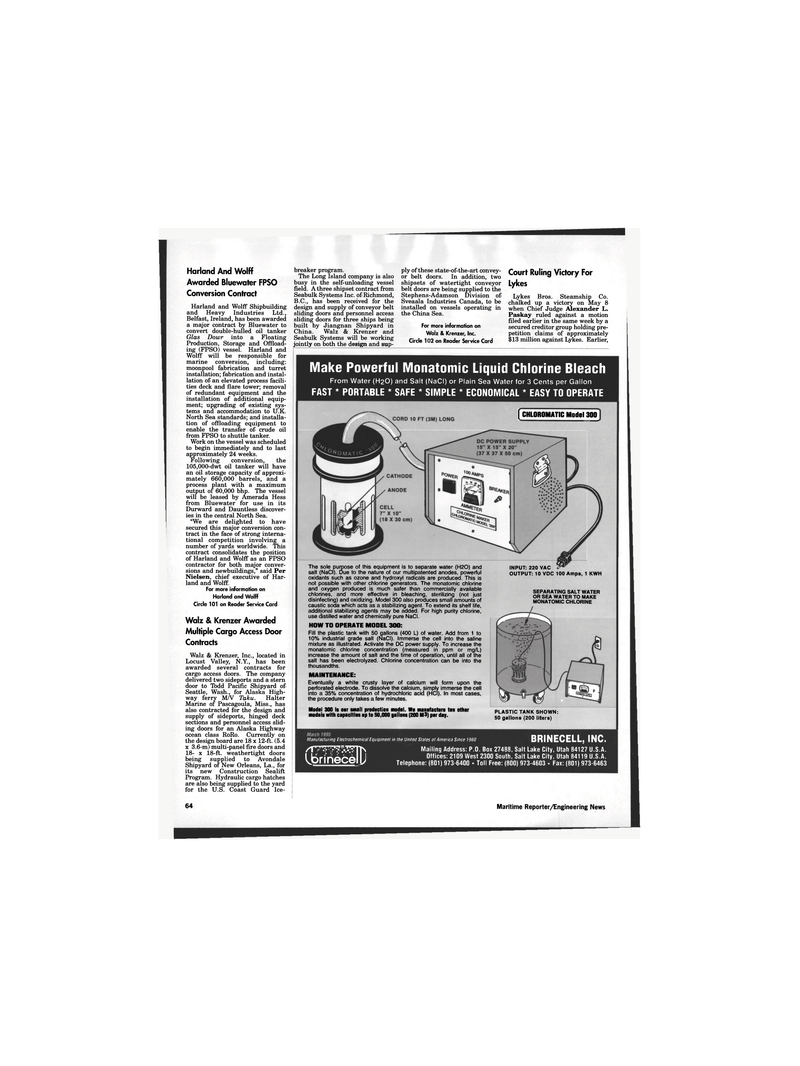
Page 62: of Maritime Reporter Magazine (June 1996)
Read this page in Pdf, Flash or Html5 edition of June 1996 Maritime Reporter Magazine
Harland And Wolff
Awarded Bluewater FPSO
Conversion Contract
Harland and Wolff Shipbuilding and Heavy Industries Ltd.,
Belfast, Ireland, has been awarded a major contract by Bluewater to convert double-hulled oil tanker
Glas Dowr into a Floating
Production, Storage and Offload- ing (FPSO) vessel. Harland and
Wolff will be responsible for marine conversion, including: moonpool fabrication and turret installation; fabrication and instal- lation of an elevated process facili- ties deck and flare tower; removal of redundant equipment and the installation of additional equip- ment; upgrading of existing sys- tems and accommodation to U.K.
North Sea standards; and installa- tion of offloading equipment to enable the transfer of crude oil from FPSO to shuttle tanker.
Work on the vessel was scheduled to begin immediately and to last approximately 24 weeks.
Following conversion, the 105,000-dwt oil tanker will have an oil storage capacity of approxi- mately 660,000 barrels, and a process plant with a maximum output of 60,000 bhp. The vessel will be leased by Amerada Hess from Bluewater for use in its
Durward and Dauntless discover- ies in the central North Sea. "We are delighted to have secured this major conversion con- tract in the face of strong interna- tional competition involving a number of yards worldwide. This contract consolidates the position of Harland and Wolff as an FPSO contractor for both major conver- sions and newbuildings," said Per
Nielsen, chief executive of Har- land and Wolff.
For more information on
Harland and Wolff
Circle 101 on Reader Service Card
Walz & Krenzer Awarded
Multiple Cargo Access Door
Contracts
Walz & Krenzer, Inc., located in
Locust Valley, N.Y., has been awarded several contracts for cargo access doors. The company delivered two sideports and a stern door to Todd Pacific Shipyard of
Seattle, Wash., for Alaska High- way ferry M/V Taku. Halter
Marine of Pascagoula, Miss., has also contracted for the design and supply of sideports, hinged deck sections and personnel access slid- ing doors for an Alaska Highway ocean class RoRo. Currently on the design board are 18 x 12-ft. (5.4 x 3.6-m) multi-panel fire doors and 18- x 18-ft. weathertight doors being supplied to Avondale
Shipyard of New Orleans, La., for its new Construction Sealift
Program. Hydraulic cargo hatches are also being supplied to the yard for the U.S. Coast Guard Ice- breaker program.
The Long Island company is also busy in the self-unloading vessel field. A three shipset contract from
Seabulk Systems Inc. of Richmond,
B.C., has been received for the design and supply of conveyor belt sliding doors and personnel access sliding doors for three ships being built by Jiangnan Shipyard in
China. Walz & Krenzer and
Seabulk Systems will be working jointly on both the design and sup- ply of these state-of-the-art convey- or belt doors. In addition, two shipsets of watertight conveyor belt doors are being supplied to the
Stephens-Adamson Division of
Sveaala Industries Canada, to be installed on vessels operating in the China Sea.
For more information on
Walz & Krenzer, Inc.
Circle 102 on Reader Service Card
Court Ruling Victory For
Lykes
Lykes Bros. Steamship Co. chalked up a victory on May 8 when Chief Judge Alexander L.
Paskay ruled against a motion filed earlier in the same week by a secured creditor group holding pre- petition claims of approximately $13 million against Lykes. Earlier,
Make Powerful Monatomic Liquid Chlorine Bleach
From Water (H2O) and Salt (NaCI) or Plain Sea Water for 3 Cents per Gallon
FAST * PORTABLE * SAFE * SIMPLE * ECONOMICAL * EASY TO OPERATE [ CHLOROMATIC Model 300
The sole purpose of this equipment is to separate water (H20) and salt (NaCI). Due to the nature of our multipatented anodes, powerful oxidants such as ozone and hydroxyl radicals are produced. This is not possible with other chlorine generators. The monatomic chlorine and oxygen produced is much safer than commercially available chlorines, and more effective in bleaching, sterilizing (not just disinfecting) and oxidizing. Model 300 also produces small amounts of caustic soda which acts as a stabilizing agent. To extend its shelf life, additional stabilizing agents may be added. For high purity chlorine, use distilled water and chemically pure NaCI.
HOW TO OPERATE MODEL 300:
Fill the plastic tank with 50 gallons (400 L) of water. Add from 1 to 10% industrial grade salt (NaCI). Immerse the cell into the saline mixture as illustrated. Activate the DC power supply. To increase the monatomic chlorine concentration (measured in ppm or mg/L) increase the amount of salt and the time of operation, until all of the salt has been electrolyzed. Chlorine concentration can be into the thousandths.
MAINTENANCE:
Eventually a white crusty layer of calcium will form upon the perforated electrode. To dissolve the calcium, simply immerse the cell into a 35% concentration of hydrochloric acid (HCI). In most cases, the procedure only takes a few minutes.
Model 300 is our small production model. We manufacture ten other models with capacities up to 50,000 gallons (200 M3) per day.
INPUT: 220 VAC
OUTPUT: 10 VDC 100 Amps, 1 KWH
SEPARATING SALT WATER
OR SEA WATER TO MAKE
MONATOMIC CHLORINE
PLASTIC TANK SHOWN: 50 gallons (200 liters)
Manufacturing Electrochemical Equipment in the United States ot America Since 1960 BRINECELLj IN 0 •
Mailing Address: P.O. Box 27488, Salt Lake City, Utah 84127 U.S.A.
Offices: 2109 West 2300 South, Salt Lake City, Utah 84119 U.S.A.
Telephone: (801) 973-6400 * Toll Free: (800) 973-4603 * Fax: (801) 973-6463
A ' " j 'tsW fs
Lorinece \J 64 Maritime Reporter/Engineering News

 61
61

 63
63
